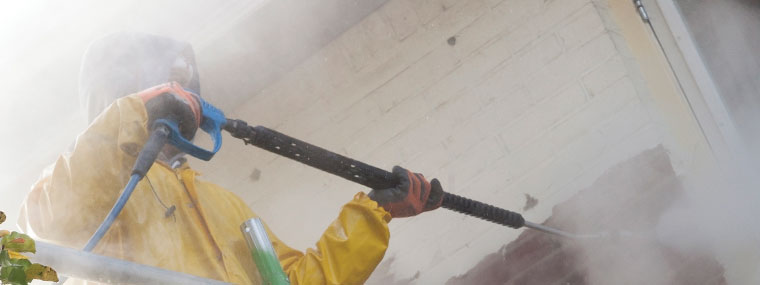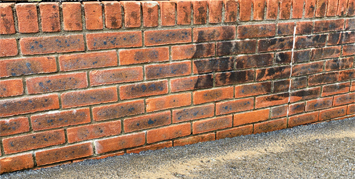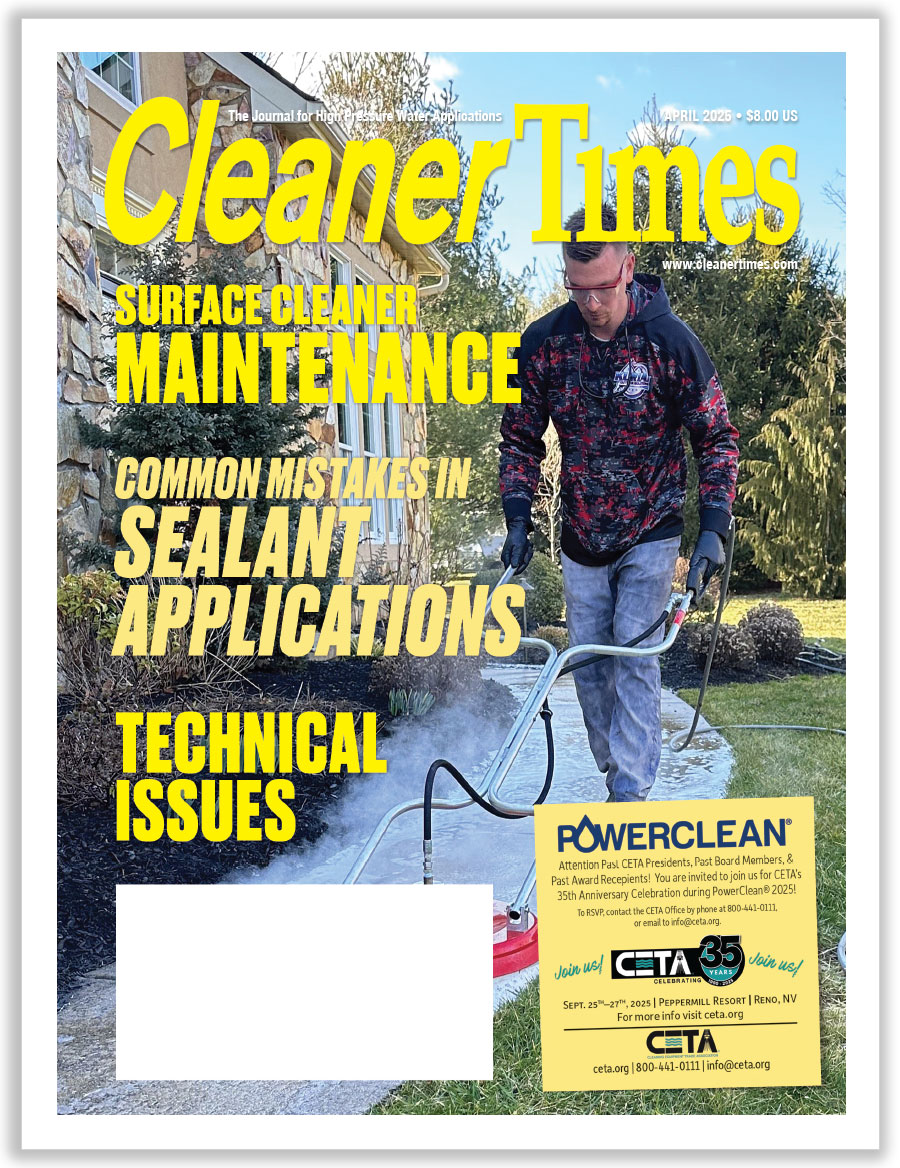
Masonry and Brick Cleaning
New Construction
By Terri Perrin, with technical supportfrom the Brick Industry Associationand Ron Baer, Unique Industries / Published January 2022

Editor’s Note: This article has been divided in two parts. Part one will cover some basic aspects of brick and masonry cleaning, but readers should plan to read part two to obtain a fuller picture of what is required for brick and masonry cleaning. Part two will be available in the February 2022 issue of Cleaner Times and will pick up with “Tips and Techniques.”
Is Brick and Masonry Cleaning For You?
Masonry finishes, such as brick and concrete blocks, are the material of choice for residential, educational, small commercial, retail, and big-box construction throughout North America. Enquiries for a contract cleaner for new masonry will usually come from building companies, construction firms, or property managers.
While opportunities may abound, Ron Baer, vice president of Colorado-based Unique Industries—Kem-O-Kleen, says that cleaning new brick and masonry isn’t something that the average pressure washing contractor would normally do. “This type of contract cleaning is considered to be a specialty service,” cautions Baer. “You can’t randomly add it to your list of offerings without the necessary training and knowledge of the proper cleaning solutions and equipment.”
The Brick Industry Association (BIA) agrees, stating that “brick and masonry cleaning operations should be performed only by personnel trained to handle the safety risks associated with this type of work and by following the label instructions.”
The BIA’s Technical Notes on Brick Construction (#20 – August 2018) state, “Recommended cleaning methods and materials vary based on the type of brick, mortar, construction, and reason for cleaning. For example, cleaning newly completed brickwork of an entire building requires a different approach from removing stains from an isolated portion of an existing wall.
“The selection of effective cleaning solutions, as well as the use of consistent and appropriate cleaning procedures throughout the job, is essential to successful cleaning and cannot be overemphasized. Improper cleaning practices can cause a host of problems that, in severe cases, cannot be repaired. Also, be aware that cleaning agents and processes may be hazardous and may cause injury if used carelessly or inappropriately.”
Brick. Masonry. Mortar. What’s the Difference?
Masonry is a broad term used to describe a wall built of masonry units, such as clay brick, concrete blocks, building stone (marble, granite, and limestone), cast stone, glass block, or adobe, which are placed next to each other and laid in mortar. A person who constructs masonry is referred to as a mason or bricklayer.
Mortar is the workable ‘paste’ which is placed between masonry units and cures to bind them together, to fill and seal the irregular gaps between them, to spread their weight evenly, and sometimes to add decorative colors or patterns to masonry walls.
(You’ll find the BIA’s 13-page downloadable PDF of Technical Notes #20 at https://tinyurl.com/2yjnxb68 or visit www.gobrick.com and check for “Technical Notes” under the “Read and Research” tab.)
Both the BIA and Ron Baer also recommend that you should always contact your chemical/cleaning product suppliers for guidance. Kansas-based Prosoco, for example, has a wealth of information on their website, as well as offering an online administrative assistant (A/A) feature, self-directed learning, and meet-up or webinar training. Their one-on-one virtual education is free and open to anyone. To arrange a webinar or online product training with one of their technical experts, visit https://tinyurl.com/ctenm2kd or go to www.Prosoco.com. Under the “Resources” tab, click on “Con-tinuing Education.”
The Masonry Contractors Asso-ciation of America (MCAA) has also developed the national Masonry Certification program, www.masoncontractors.org. This training, however, is for MCAA members only and is not necessarily specific to cleaning as it covers several facets of the industry.
Typical Job
New masonry should be cleaned within one month of completion of masonry construction. Depending on the size and phasing of the project, it may be necessary to clean the elevations of the building that were constructed first before all the masonry is completed. The purpose is to remove construction dirt and mortar smears from the face of the masonry and clear away excess mortar from masonry joints (between courses of brick or concrete masonry units). Mortar smears will appear as white or gray streaks.
There are hundreds of types of brick and cement blocks, all with different textures, porousness, colors, and more. Mortar varies in composition, dyes, and additives, too. While cleaning processes may be the same for different sorts of concrete masonry, different cleaning processes may be required for different types of brick masonry.
Chemical cleaning agents formulated specifically to work with brick masonry must be used. Do not use undiluted cleaners unless required by the cleaner manufacturer, and be aware that not all brick masonry can be cleaned with pressurized water.
Cleaning can usually begin within days of masonry being laid; however, be aware that the mortar must be sufficiently hard (set/cured) for the cleaning process used, typically 24 hours to seven days after completion.
Project Considerations
The BIA stresses that “prior to beginning masonry cleaning, there are a number of considerations common to all projects that should be addressed during the planning process.” Their recommendations, along with insight from Ron Baer, follow:
Preplanning and set-up:
Safety first! Some chemicals used to clean masonry may be harmful if splashed on your skin or in your eyes, or if the fumes are inhaled. Protecting people and property is essential. Always use the appropriate PPE, such as a breathing apparatus to protect from acid inhalation, a full-face shield, safety glasses, chemical gloves, steel-toed rubber boots, chemical suit, hard hat, etc. Ensure proper ventilation and exercise safe handling practices according to OSHA requirements.
It is imperative that you use the appropriate cleaning procedure for the substrate surface—i.e., match the cleaning method, type of tools required, and cleaning solution type (and concentration) to the type of brick—and verify that they are approved by the brick manufacturer.
Contact the brick manufacturer to confirm their cleaning recommendations. For general information about cleaning, refer to table #1 on page four of the BIA’s Technical Note 20–Cleaning Brickwork.
Work with your cleaner supplier and read labels to determine the correct product to use and dilution formulas.
Prior to commencing work, protect surrounding areas such as cast stone, window/door frames, decorative or concrete elements, and vegetation to prevent damage by the cleaning chemical and overspray. Move vehicles away from the spray zone.
Always select the gentlest cleaning method that is effective, as determined by trial cleaning.
Perform trial cleaning on a 20-square-foot sample area in an inconspicuous location of the wall, and allow it to fully dry before evaluating results. (Note that drying can take up to a week, not just a few hours.)
For some projects, multiple cleaning trials may be required in order to achieve acceptable results. Trial cleaning, especially on larger, more complex projects, not only serves as a means to determine whether mortar or stains can be removed but also helps to identify the most effective procedures that will cause the least damage to the masonry.
Do not allow the cleaning solution to dry on brickwork—pre-wet the areas, keep wet, and rinse thoroughly once complete.
Do not use unbuffered muriatic (hydrochloric) or hydrofluoric acid.
Comply with federal, state, and local regulations with regard to disposal of chemicals and wastewater containment/disposal, if required.
Ron Baer is vice president of Unique Industries-Kem-O-Kleen in Denver, CO, and is a member of Masonry Contractors Association of America. He has been involved in the masonry cleaning industry for over 30 years. Ron is a frequent contributor to masonry cleaning articles in Masonry Magazine and other trade periodicals.
The Brick Industry Association (BIA) provides a broad range of programs and services that fulfill its mission of promoting and safeguarding the clay brick industry. BIA promotes the industry through education and promotional programs; safeguards the industry through comprehensive advocacy and compliance efforts at the federal and state levels; provides representation in all model building code forums and national standards committees; and is involved in local advocacy programs that educate local planning and elected officials about clay brick. www.gobrick.com.






